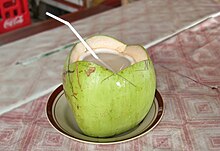
Orange juice is a liquid extract of the orange tree fruit, produced by squeezing or reaming oranges. It comes in several different varieties, including blood orange, navel oranges, valencia orange, clementine, and tangerine. As well as variations in oranges used, some varieties include differing amounts of juice vesicles, known as "pulp" in American English, and "(juicy) bits" in British English. These vesicles contain the juice of the orange and can be left in or removed during the manufacturing process. How juicy these vesicles are depend upon many factors, such as species, variety, and season. In American English, the beverage name is often abbreviated as "OJ".

Chocolate milk is a type of flavoured milk made by mixing cocoa solids with milk. It is a food pairing in which the milk's mouthfeel masks the dietary fibres of the cocoa solids.

Buttermilk is a fermented dairy drink. Traditionally, it was the liquid left behind after churning butter out of cultured cream. As most modern butter in Western countries is not made with cultured cream but uncultured sweet cream, most modern buttermilk in Western countries is cultured separately. It is common in warm climates where unrefrigerated milk sours quickly.
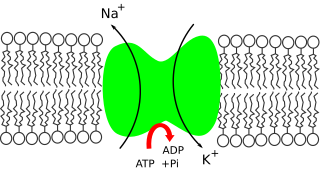
Potassium is the main intracellular ion for all types of cells, while having a major role in maintenance of fluid and electrolyte balance. Potassium is necessary for the function of all living cells, and is thus present in all plant and animal tissues. It is found in especially high concentrations within plant cells, and in a mixed diet, it is most highly concentrated in fruits. The high concentration of potassium in plants, associated with comparatively very low amounts of sodium there, historically resulted in potassium first being isolated from the ashes of plants (potash), which in turn gave the element its modern name. The high concentration of potassium in plants means that heavy crop production rapidly depletes soils of potassium, and agricultural fertilizers consume 93% of the potassium chemical production of the modern world economy.
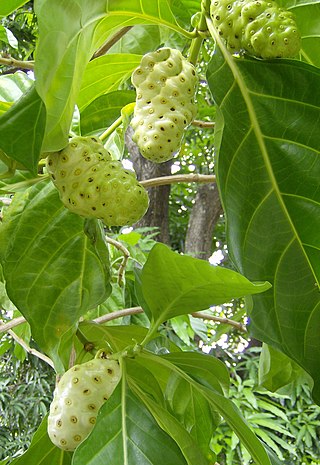
Morinda citrifolia is a fruit-bearing tree in the coffee family, Rubiaceae, native to Southeast Asia and Australasia, and was spread across the Pacific by Polynesian sailors. The species is now cultivated throughout the tropics and widely naturalized. There are over 100 names for this fruit across different regions. Common English names include great morinda, Indian mulberry, noni, beach mulberry, vomit fruit, awl tree, and cheese fruit.
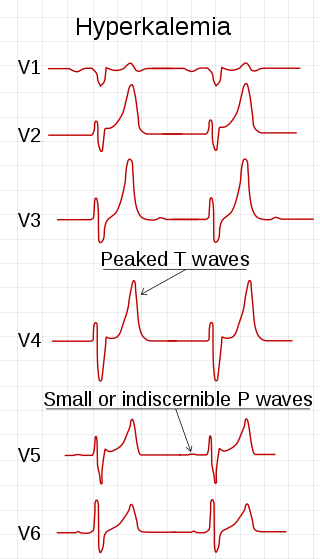
Hyperkalemia is an elevated level of potassium (K+) in the blood. Normal potassium levels are between 3.5 and 5.0 mmol/L (3.5 and 5.0 mEq/L) with levels above 5.5 mmol/L defined as hyperkalemia. Typically hyperkalemia does not cause symptoms. Occasionally when severe it can cause palpitations, muscle pain, muscle weakness, or numbness. Hyperkalemia can cause an abnormal heart rhythm which can result in cardiac arrest and death.
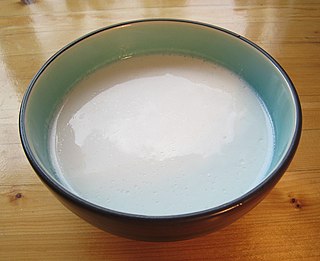
Coconut milk is an opaque, milky-white liquid extracted from the grated pulp of mature coconuts. The opacity and rich taste of coconut milk are due to its high oil content, most of which is saturated fat. Coconut milk is a traditional food ingredient used in Southeast Asia, Oceania, South Asia, and East Africa. It is also used for cooking in the Caribbean, tropical Latin America, and West Africa, where coconuts were introduced during the colonial era.

Electrolyte imbalance, or water-electrolyte imbalance, is an abnormality in the concentration of electrolytes in the body. Electrolytes play a vital role in maintaining homeostasis in the body. They help to regulate heart and neurological function, fluid balance, oxygen delivery, acid–base balance and much more. Electrolyte imbalances can develop by consuming too little or too much electrolyte as well as excreting too little or too much electrolyte. Examples of electrolytes include calcium, chloride, magnesium, phosphate, potassium, and sodium.

Cranberry juice is the liquid juice of the cranberry – a fruit recognized for its bright red color, tart taste, and versatility for product manufacturing. Major cranberry products include cranberry juice, dried cranberry, cranberry sauce, frozen cranberry, cranberry powder, and dietary supplements containing cranberry extracts.

Prune juice is a fruit juice derived from prunes that have been rehydrated. It is a mass-produced product that is often produced using a hot extraction method, and juice concentrate is typically produced using a low-temperature extraction method. It may be used as a dietary supplement to act as a laxative. It is also sometimes used as a flavor enhancer in tobacco products. It is an ingredient in many cocktails, such as the Purple Dragon, or Constipolitan.

Agave syrup, also known as maguey syrup or agave nectar, is a sweetener commercially produced from several species of agave, including Agave tequilana and Agave salmiana. Blue-agave syrup contains 56% fructose as a sugar providing sweetening properties.

Naked Juice is an American brand that produces juices and smoothies. The company is based in Monrovia, California and is owned by PAI Partners. The first Naked Juice drink was produced in 1983 and sold in California under the name "Naked Juice", referring to the composition of no artificial flavors, added sugar, or preservatives. Distribution has since expanded, and Naked Juice products are distributed in the United States, as well as in Canada, the United Kingdom, the Netherlands and France, among others.
ConsumerLab.com, LLC. is a privately held American company registered in White Plains, NY. It is a publisher of test results on health, wellness, and nutrition products. Consumer Labs is not a laboratory, but contracts studies to outside testing laboratories. It purchases dietary supplement products and other consumer goods directly from public storefronts and online retailers, contracts for testing by private laboratories, and publishes reports based on the results. It primarily derives revenue from the sale of subscriptions to its online publications, which are paywalled. Other sources of revenue include a proprietary certification program, licensing fees, contents re-publication license fees, and advertising.

Pineapple juice is a juice made from pressing the natural liquid out from the pulp of the pineapple. Numerous pineapple varieties may be used to manufacture commercial pineapple juice, the most common of which are Smooth Cayenne, Red Spanish, Queen, and Abacaxi. In manufacturing, pineapple juice is typically canned.
Potassium binders are medications that bind potassium ions in the gastrointestinal tract, thereby preventing its intestinal absorption. This category formerly consisted solely of polystyrene sulfonate, a polyanionic resin attached to a cation, administered either orally or by retention enema to patients who are at risk of developing hyperkalaemia. Newer drugs include: another polyanionic polymer, patiromer, which exchanges calcium for potassium; and Sodium zirconium cyclosilicate crystals, which exchange sodium for potassium

Creamed coconut, also known as coconut butter, is a coconut product made from the unsweetened dehydrated fresh pulp of a mature coconut, ground to a semi-solid white creamy paste. It is sold in the form of a hard white block which can be stored at room temperature. The block is generally packaged in a sealed plastic pouch and some separation of the fat and the coconut flesh can be seen. In cookery, it is chopped into pieces or grated before it is added to dishes. By adding warm water it can be made into coconut milk or coconut cream substitutes. Adding water to creamed coconut in the ratio 5:2 gives coconut cream substitute, 5:1 coconut milk substitute.

Samalamig, also known as palamig, is a collective term for various Filipino sweet chilled beverages that usually include jelly-like ingredients. They come in various flavors, and are commonly sold by street vendors as refreshments. Typical ingredients of the drinks include gulaman (agar), sago pearls, kaong, tapioca pearls, nata de coco, and coconut. They are usually anglicized as pearl coolers or pearl and jelly coolers.
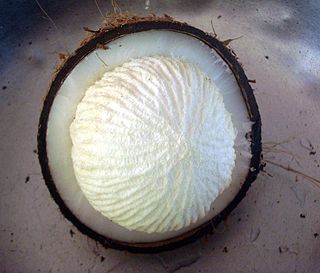
Sprouted coconuts, also referred to as coconut sprouts, are the edible spherical sponge-like cotyledons of germinating coconuts. They have a crunchy watery texture with a slight sweetness. They are eaten in coconut-growing countries either as it is or as part of various dishes. They are not commercially produced. They are also known variously as coconut pearls, coconut embryos, coconut candy, coconut apples, coconut cotyledons or simply coconembryos or coconapples.
Nata de piña, also marketed as pineapple gel or pineapple gelatin, is a chewy, translucent, jelly-like food produced by the fermentation of pineapple juice. It is a traditional dessert in the Philippines, produced since the 18th century using waste pineapple juices from the piña fiber industry in Pagsanjan, Laguna. It has a sweet-sour taste and is popularly used in fruit salads, jams, ice creams, candies, and various other dishes.

The Vita Coco Company, doing business as simply Vita Coco, is an American beverage company which mainly sells coconut water. The largest brand globally in coconut/plant waters, Vita Coco has operations in 31 countries as of 2016. It is a benefit corporation. The company is owned by All Market Inc.
